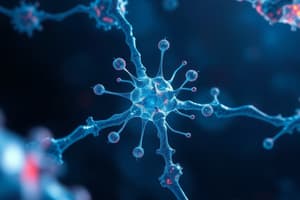Podcast
Questions and Answers
What is the main function of the cell membrane?
What is the main function of the cell membrane?
- To provide energy for the cell
- To separate the cell from its environment (correct)
- To perform protein synthesis
- To store genetic material
Which type of biomolecule provides energy and structure for cells?
Which type of biomolecule provides energy and structure for cells?
- Nucleic acids
- Proteins
- Carbohydrates (correct)
- Lipids
What is the primary function of enzymes?
What is the primary function of enzymes?
- To store genetic material
- To synthesize proteins
- To provide energy for the cell
- To catalyze chemical reactions (correct)
What is the term for the process by which cells take in oxygen and release carbon dioxide?
What is the term for the process by which cells take in oxygen and release carbon dioxide?
What is the primary function of enzymes in biological systems?
What is the primary function of enzymes in biological systems?
Which enzyme is responsible for breaking down starch?
Which enzyme is responsible for breaking down starch?
What is the primary function of the small intestine in the digestive system?
What is the primary function of the small intestine in the digestive system?
What is the primary function of gas exchange in humans?
What is the primary function of gas exchange in humans?
Where does gas exchange occur in the human body?
Where does gas exchange occur in the human body?
What is the importance of digestion in the human body?
What is the importance of digestion in the human body?
Flashcards are hidden until you start studying
Study Notes
Cells
- Basic structural and functional units of life
- Consist of:
- Cell membrane (plasma membrane): semi-permeable membrane that separates cell from environment
- Cytoplasm: jelly-like substance inside cell membrane
- Nucleus: contains genetic material (DNA)
- Cell types:
- Prokaryotic cells: lack true nucleus, e.g. bacteria
- Eukaryotic cells: have true nucleus, e.g. plants, animals, fungi
Biological Molecules
- Carbohydrates:
- Provide energy and structure for cells
- Examples: glucose, starch, cellulose
- Proteins:
- Perform various functions, e.g. enzymes, hormones, structural components
- Examples: hemoglobin, insulin, collagen
- Lipids:
- Provide energy and structure for cells
- Examples: fats, oils, cholesterol
- Nucleic acids:
- Contain genetic information (DNA, RNA)
- Examples: DNA, RNA
Variety of Living Organisms
- Classification:
- Domain: highest level of classification
- Kingdom: second level of classification
- Phylum: third level of classification
- Class: fourth level of classification
- Order: fifth level of classification
- Family: sixth level of classification
- Genus: seventh level of classification
- Species: most specific level of classification
- Types of organisms:
- Monera: single-celled organisms, e.g. bacteria
- Protista: single-celled eukaryotes, e.g. protozoa
- Fungi: e.g. mushrooms, yeast
- Plantae: e.g. plants, trees
- Animalia: e.g. animals, humans
Enzymes
- Biological molecules that catalyze chemical reactions
- Characteristics:
- Specificity: each enzyme has a specific substrate
- Optimized temperature and pH: enzymes work best at specific temperatures and pH levels
- Increased reaction rate: enzymes speed up chemical reactions
- Types of enzymes:
- Amylase: breaks down starch
- Protease: breaks down proteins
- Lipase: breaks down lipids
Digestion
- Breakdown of food into smaller molecules that can be absorbed and utilized by the body
- Digestive system:
- Mouth: mechanical and chemical breakdown of food (saliva contains amylase)
- Stomach: chemical breakdown of food (gastric acid and pepsin)
- Small intestine: absorption of nutrients
- Large intestine: water absorption and waste elimination
- Importance of digestion:
- Provides energy and nutrients for the body
Gas Exchange in Humans
- Process of exchanging oxygen and carbon dioxide between the environment and the body
- Respiratory system:
- Nose and mouth: air enters the body
- Trachea: air passes through the trachea
- Bronchi: air passes through the bronchi
- Alveoli: gas exchange occurs
- Process of gas exchange:
- Oxygen diffuses into the bloodstream
- Carbon dioxide diffuses out of the bloodstream
- Importance of gas exchange:
- Provides oxygen for cellular respiration
- Removes waste product (carbon dioxide)
Cells
- Cells are the basic structural and functional units of life
- Cell components include:
- Cell membrane (plasma membrane): semi-permeable membrane separating cell from environment
- Cytoplasm: jelly-like substance inside cell membrane
- Nucleus: contains genetic material (DNA)
- Cell types:
- Prokaryotic cells: lack true nucleus, e.g. bacteria
- Eukaryotic cells: have true nucleus, e.g. plants, animals, fungi
Biological Molecules
- Carbohydrates:
- Provide energy and structure for cells
- Examples: glucose, starch, cellulose
- Proteins:
- Perform various functions, e.g. enzymes, hormones, structural components
- Examples: hemoglobin, insulin, collagen
- Lipids:
- Provide energy and structure for cells
- Examples: fats, oils, cholesterol
- Nucleic acids:
- Contain genetic information (DNA, RNA)
- Examples: DNA, RNA
Variety of Living Organisms
- Classification levels:
- Domain: highest level of classification
- Kingdom: second level of classification
- Phylum: third level of classification
- Class: fourth level of classification
- Order: fifth level of classification
- Family: sixth level of classification
- Genus: seventh level of classification
- Species: most specific level of classification
- Types of organisms:
- Monera: single-celled organisms, e.g. bacteria
- Protista: single-celled eukaryotes, e.g. protozoa
- Fungi: e.g. mushrooms, yeast
- Plantae: e.g. plants, trees
- Animalia: e.g. animals, humans
Enzymes
- Enzymes are biological molecules that catalyze chemical reactions
- Characteristics:
- Specificity: each enzyme has a specific substrate
- Optimized temperature and pH: enzymes work best at specific temperatures and pH levels
- Increased reaction rate: enzymes speed up chemical reactions
- Examples of enzymes:
- Amylase: breaks down starch
- Protease: breaks down proteins
- Lipase: breaks down lipids
Digestion
- Digestion is the breakdown of food into smaller molecules that can be absorbed and utilized by the body
- Digestive system components:
- Mouth: mechanical and chemical breakdown of food (saliva contains amylase)
- Stomach: chemical breakdown of food (gastric acid and pepsin)
- Small intestine: absorption of nutrients
- Large intestine: water absorption and waste elimination
- Importance of digestion:
- Provides energy and nutrients for the body
Gas Exchange in Humans
- Gas exchange is the process of exchanging oxygen and carbon dioxide between the environment and the body
- Respiratory system components:
- Nose and mouth: air enters the body
- Trachea: air passes through the trachea
- Bronchi: air passes through the bronchi
- Alveoli: gas exchange occurs
- Process of gas exchange:
- Oxygen diffuses into the bloodstream
- Carbon dioxide diffuses out of the bloodstream
- Importance of gas exchange:
- Provides oxygen for cellular respiration
- Removes waste product (carbon dioxide)
Studying That Suits You
Use AI to generate personalized quizzes and flashcards to suit your learning preferences.




